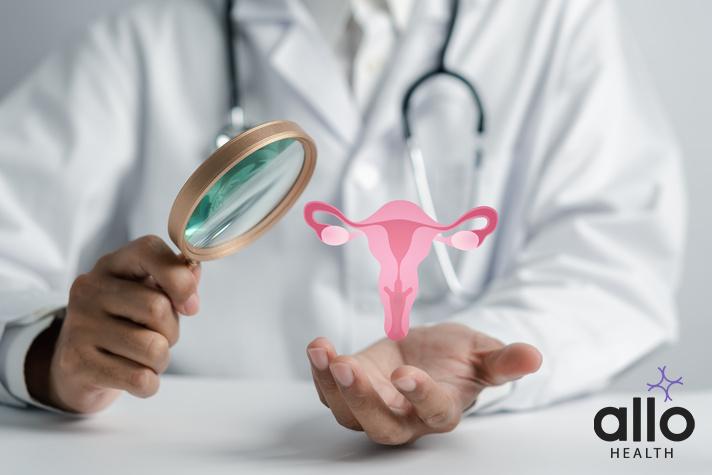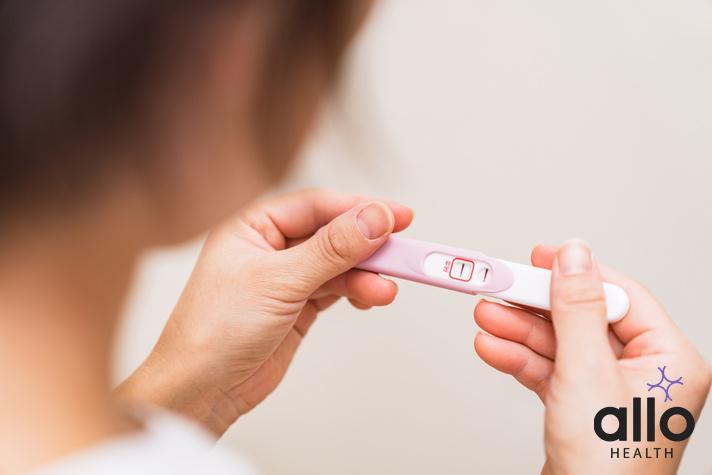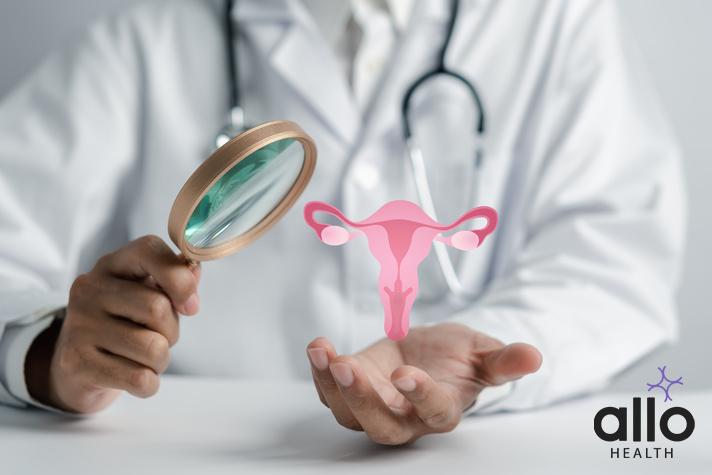Debunking the Myth: Are Small Breasts a Sign of Infertility?

Allo Health is dedicated to personalized well-being, offering support and trusted information tailored to individual health goals. The platform emphasizes human-generated content, led by a distinguished medical team of experts, including physicians and sexual health specialists. Their commitment to credibility involves rigorous fact-checking, authoritative research, and continuous updates to ensure accurate, up-to-date information. Allo Health's unique approach goes beyond conventional platforms, providing expert-led insights and a continuous commitment to excellence, with user feedback playing a crucial role in shaping the platform's authoritative voice.

Dr. Aditi completed her undergraduate medical education at AJIMS, Mangalore, after which she worked in multi-speciality hospitals with COVID patients and in the Pain and Palliative medicine department. Driven by her experiences, she developed a keen interest in psychiatry. Dr. Aditi believes that mental health is just as, if not more important, than physical health.
Why This Was Upated?
Our experts continually monitor the health and wellness space, and we update our articles when new information became available.
Updated on 13 April, 2024
- Article was updated as part of our commitment to diversity, equity, and inclusion.

"The following blog article provides general information and insights on various topics. However, it is important to note that the information presented is not intended as professional advice in any specific field or area. The content of this blog is for general educational and informational purposes only.
Book consultation
The content should not be interpreted as endorsement, recommendation, or guarantee of any product, service, or information mentioned. Readers are solely responsible for the decisions and actions they take based on the information provided in this blog. It is essential to exercise individual judgment, critical thinking, and personal responsibility when applying or implementing any information or suggestions discussed in the blog."
In the realm of fertility and reproductive health, myths and misconceptions often abound, leading to confusion and unnecessary worry among individuals. One such misconception is the belief that small breast size is a clear indicator of infertility. However, this assumption lacks scientific backing and can contribute to harmful stereotypes and body image issues.
Defining Small Breast Size
Breast size varies widely, with the smallest cup size available in the UK typically being AA. However, what constitutes a “small” breast size can vary based on individual body proportions. For instance, what may seem small on a taller, broader woman might appear larger on a smaller, slighter frame.
Breast size is determined by the ratio between the fullest part of the breast and the measurement around the rib cage. Therefore, a 38AA cup would be proportionally larger than a 32AA cup, despite both being labeled as AA. It’s essential to recognize that having an A cup doesn’t equate to being flat-chested.
In India, the cup size convention may vary slightly from the UK. The smallest cup size available in India is often denoted as A, with variations such as AA also being available. Similar to other regions, societal influences, and media portrayals can shape perceptions of breast size. Despite these influences, it’s important to embrace and celebrate diverse body shapes and sizes, without succumbing to societal pressures or unrealistic ideals.
Several factors contribute to why some women have small breasts
- Genetics: Most women are genetically predisposed to their breast size, just as they are programmed to be a certain height or weight. This genetic influence primarily determines breast size and shape, with variations occurring among individuals.
- Aesthetic Considerations: Small breasts are often considered aesthetic rather than a medical condition. While some women may have post-puberty underdeveloped breasts, known as micromastia, it’s essential to differentiate between aesthetic preferences and medical conditions.
- Micromastia: Micromastia, also referred to as hypomastia, breast hypoplasia, or mammary hypoplasia, is a medical condition characterized by underdeveloped breasts after puberty. In rare cases, women may have very little or no breast tissue at all (amazia) or may lack breast tissue along with the nipple or areola (amastia).
- Relative Nature of Breast Size: There is no formal definition of “small breasts” due to their relative nature. For example, a tall woman with a certain volume of breast tissue may appear to have larger breasts compared to a shorter woman with the same volume of breast tissue. The perception of breast size often depends on the individual’s overall body proportions.
- Congenital Conditions: Some congenital conditions can lead to micromastia, including Ulnar-mammary syndrome, Poland syndrome, Turner syndrome, and congenital adrenal hyperplasia. These conditions may affect breast development during fetal or puberty, resulting in smaller breast size.
In summary, genetics, aesthetic preferences, medical conditions such as micromastia, and congenital factors can influence small breast size. It’s essential to recognize that breast size varies among individuals and is not a measure of beauty or femininity. Embracing diverse body shapes and sizes is crucial for promoting body positivity and self-acceptance.
Breast Size and Fertility
Breast size is primarily determined by genetics, hormonal balance, body composition, and age. Variations in breast size are entirely normal and do not affect a woman’s ability to conceive or carry a pregnancy to term.
- Genetics: Genetics plays a significant role in determining breast size. A woman’s genetic makeup dictates the development of breast tissue, including its size, shape, and density. Family history often influences breast size, with daughters often sharing similar characteristics to their mothers or female relatives. However, regardless of genetic predisposition, breast size varies widely among individuals and does not serve as a reliable predictor of fertility.
- Hormonal Balance: Hormonal fluctuations throughout a woman’s life can affect breast size. During puberty, increased levels of estrogen stimulate breast development, leading to growth and changes in size and shape. Similarly, hormonal changes during the menstrual cycle, pregnancy, and menopause can also impact breast size temporarily. However, these hormonal variations are natural processes that do not reflect fertility status.
- Body Composition: Body composition, including factors such as weight, muscle mass, and overall body fat percentage, can influence breast size. Women with higher body fat percentages may have larger breast sizes due to the presence of adipose tissue, which contributes to breast volume. However, it’s essential to recognize that breast size is not solely determined by body fat and can vary independently of overall body size and composition.
- Age: Breast size can change over time due to the aging process. As women age, changes in hormone levels, loss of skin elasticity, and changes in breast tissue density can affect breast size and shape. Additionally, factors such as pregnancy, breastfeeding, and fluctuations in weight over the years can further alter breast appearance. However, these changes are normal aspects of the aging process and do not indicate infertility.
In summary, breast size is influenced by a combination of genetic, hormonal, and environmental factors, but it does not have a direct impact on a woman’s fertility. Regardless of breast size, women are fully capable of conceiving and carrying a pregnancy to term as long as other aspects of reproductive health are in good condition.
It’s important to emphasize body positivity and debunk myths that link breast size to fertility. Every woman’s body is unique, and variations in breast size are entirely normal and natural. Focusing on accurate information and understanding the complexities of fertility can help promote a healthier and more inclusive perspective on reproductive health.
Complexity of Fertility
Fertility is a multifaceted aspect of reproductive health involving factors such as ovarian function, hormonal regulation, menstrual cycle regularity, uterine health, and sperm quality. Breast size does not play a significant role in these intricate processes.
- Ovarian Function: The ovaries play a central role in fertility by producing eggs (ova) and releasing them during ovulation. Ovarian function is regulated by a delicate balance of hormones, including estrogen levels and progesterone. Disorders such as polycystic ovary syndrome (PCOS) or premature ovarian insufficiency (POI) can impact ovarian function and affect fertility. However, breast size has no direct association with ovarian function or the ability to produce viable eggs.
- Hormonal Regulation: Hormones are crucial in regulating the menstrual cycle and fertility. The hypothalamus, pituitary gland, and ovaries communicate through a complex hormonal feedback system to control ovulation, menstruation, and reproductive processes. Imbalances in hormone levels, such as elevated prolactin or thyroid dysfunction, can disrupt fertility. While hormonal fluctuations may affect breast size temporarily, they do not impact fertility directly.
- Menstrual Cycle Regularity: A regular menstrual cycle is indicative of healthy reproductive function. The menstrual cycle involves a series of hormonal changes that prepare the body for potential pregnancy. Irregularities in the menstrual cycle, such as irregular ovulation or absent periods (amenorrhea), can signal underlying reproductive health issues. However, these irregularities are not related to breast size and do not affect fertility in a significant way.
- Uterine Health: The uterus plays a critical role in pregnancy by providing a suitable environment for implantation and fetal development. Conditions affecting uterine health, such as fibroids, polyps, or uterine anomalies, can interfere with fertility and increase the risk of miscarriage. However, these conditions are unrelated to breast size and are diagnosed through imaging studies and other diagnostic tests.
- Sperm Quality: Male fertility is equally important in the conception process. Sperm quality, including sperm count, motility, and morphology, can impact fertility outcomes. Factors such as age, lifestyle choices, and medical conditions can affect sperm production and function. However, breast size has no bearing on sperm quality or male fertility.
In summary, fertility is a complex interplay of various factors, including ovarian function, hormonal regulation, menstrual cycle regularity, uterine health, and sperm quality. While breast size may fluctuate due to hormonal changes, it does not play a significant role in these intricate processes. It’s essential to focus on accurate information and address underlying factors affecting fertility rather than attributing fertility outcomes to arbitrary physical characteristics like breast size.
Dispelling Fertility Myths: Separating Fact from Fiction
Despite advancements in medical knowledge, persistent myths surrounding fertility continue to mislead individuals. It’s crucial to debunk these misconceptions with evidence-based information. Let’s examine some common fertility myths and uncover the truth:
Myth 1: Women with small breasts are infertile.
Fact: There is no scientific correlation between breast size and fertility. Breasbret size is primarily determined by genetics and does not impact a woman’s ability to conceive.
Myth 2: Being underweight reduces one’s chance of conceiving.
Fact: While being underweight can affect fertility by disrupting hormonal balance, it does not necessarily render someone infertile. Proper nutrition and maintaining a healthy weight are essential for reproductive health.
Myth 3: Being overweight makes a woman infertile.
Fact: Obesity is associated with infertility due to hormonal imbalances and other health complications. However, it’s crucial to distinguish between being overweight and being obese. Moderate weight loss can often improve fertility outcomes for overweight individuals.
Myth 4: Having long hair is a sign of fertility.
Fact: While long hair and healthy nails may indicate good overall health, they are not reliable indicators of fertility. Fertility is influenced by various factors such as hormonal balance, ovarian function, and reproductive health, which are not related to hair length.
By debunking these fertility myths and providing accurate information, we empower individuals to make informed decisions about their reproductive health. It’s essential to rely on scientific evidence rather than outdated beliefs when discussing fertility-related topics.
When to See a Doctor: Understanding Breast Changes
Knowing when to see a doctor regarding breast changes is important for maintaining overall health and well-being. While many breast changes are normal and harmless, some may require medical attention. Here are some instances when it’s advisable to consult with a healthcare professional:
- Lumps: If you notice any new or unusual lumps in your breasts or underarm area, it’s essential to have them evaluated by a doctor. While most breast lumps are benign, some may indicate underlying issues such as cysts or, rarely, breast cancer.
- Redness, Warmth, or Swelling: Any significant changes in the appearance or sensation of your breasts, including redness, warmth, or swelling, should be discussed with a healthcare provider. These symptoms could be signs of infection or inflammation that require treatment.
- Pain: Persistent or severe breast pain that interferes with daily activities should be addressed by a doctor. While breast pain is often benign and related to hormonal changes, it’s essential to rule out more serious conditions such as mastitis or fibrocystic breast changes.
- Change in Size, Shape, or Color: Any noticeable changes in the size, shape, or color of your breasts should be evaluated by a healthcare professional. These changes could be indicative of various conditions, including hormonal fluctuations, benign breast conditions, or, in rare cases, breast cancer.
- Itching and/or Rashes: Persistent itching, redness, or rashes on or around the breast area may warrant medical attention. These symptoms could be caused by skin conditions such as eczema or contact dermatitis, but it’s important to rule out other potential causes.
- Discharge: Any abnormal discharge from the nipples, especially if it is bloody, should be investigated by a doctor. While nipple discharge can sometimes be benign, it may also indicate underlying issues such as infection, hormonal imbalances, or, in rare cases, breast cancer.
Additionally, if you have concerns about underdeveloped breasts that may impact your ability to breastfeed or other aspects of your health, it’s advisable to discuss them with a healthcare provider. They can assess your situation, provide guidance, and address any underlying medical causes if necessary.
Conclusion:
In conclusion, myths and misconceptions surrounding fertility, breast size, and reproductive health persist in society. Despite scientific evidence refuting these notions, they continue to influence perceptions and cause unnecessary worry among individuals. Through this exploration, we have debunked the myth that small breast size is a clear indicator of infertility. Breast size is primarily determined by genetics, hormonal balance, and other factors, and does not correlate with fertility.
Furthermore, we have addressed common fertility myths, emphasizing the importance of relying on evidence-based information rather than outdated beliefs. Understanding the complexities of fertility and reproductive health is crucial for promoting informed decision-making and dispelling harmful stereotypes.
Additionally, we have highlighted the importance of seeking medical attention for any concerning breast changes, regardless of breast size. Early detection and evaluation of abnormalities can lead to timely interventions and improved health outcomes.
In essence, by challenging misconceptions, promoting body positivity, and prioritizing accurate information, we can foster a healthier and more inclusive dialogue surrounding fertility and reproductive health. It’s essential to empower individuals to make informed choices and embrace the diversity of human bodies without judgment or stigma. Through education and awareness, we can work towards a society where everyone feels confident, supported, and empowered in their reproductive journey.
Most Asked Questions
-
Does breast size affect fertility?
No, breast size does not have a direct impact on fertility. Fertility is primarily determined by factors such as ovarian function, hormonal balance, menstrual cycle regularity, uterine health, and sperm quality.
-
Can women with small breasts conceive?
Yes, women with small breasts are fully capable of conceiving and carrying a pregnancy to term. Breast size is not indicative of fertility, and individuals of all breast sizes can have healthy reproductive outcomes.
-
Are there medical conditions that cause small breast size?
Yes, some medical conditions, such as micromastia (hypomastia), can result in underdeveloped breasts after puberty. Additionally, congenital conditions like Ulnar-mammary syndrome, Poland syndrome, Turner syndrome, and congenital adrenal hyperplasia may affect breast development.
-
Is it necessary to see a doctor for concerns about breast size?
While breast size itself is not typically a cause for medical concern, it's essential to consult a healthcare professional if you have concerns about underdeveloped breasts or notice any unusual breast changes. A doctor can assess your situation and address any underlying medical issues.
-
Are there myths about breast size and fertility?
Yes, there are several myths surrounding breast size and fertility, including the misconception that small breasts indicate infertility. It's crucial to rely on evidence-based information and debunk these myths to promote accurate understanding and body positivity.






































